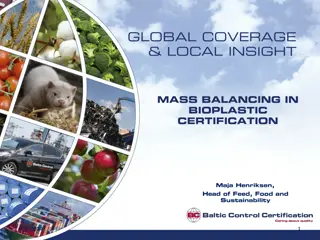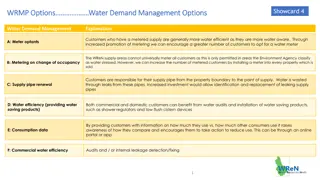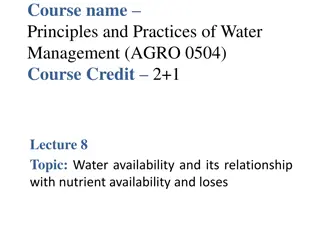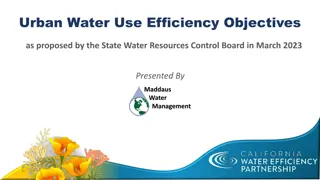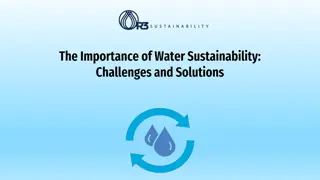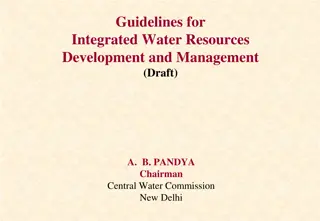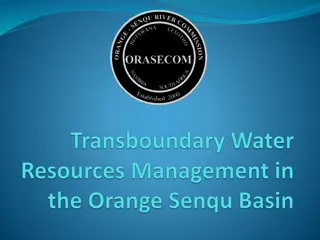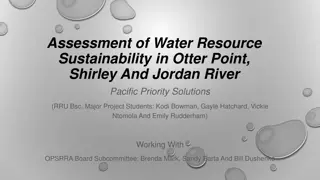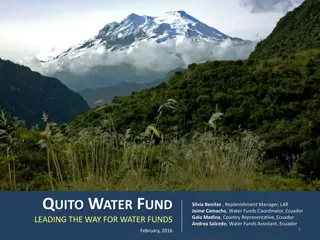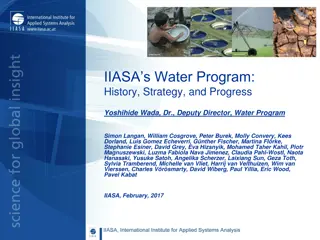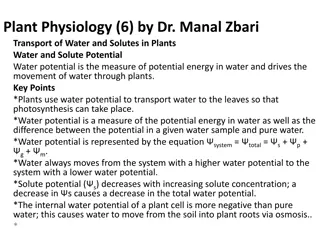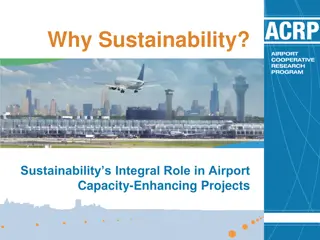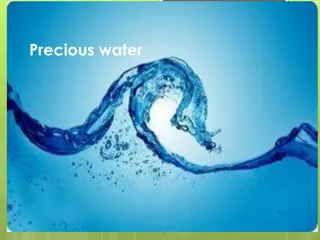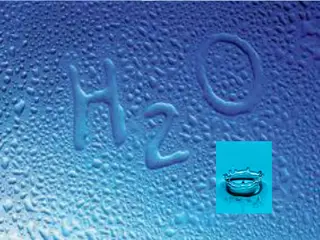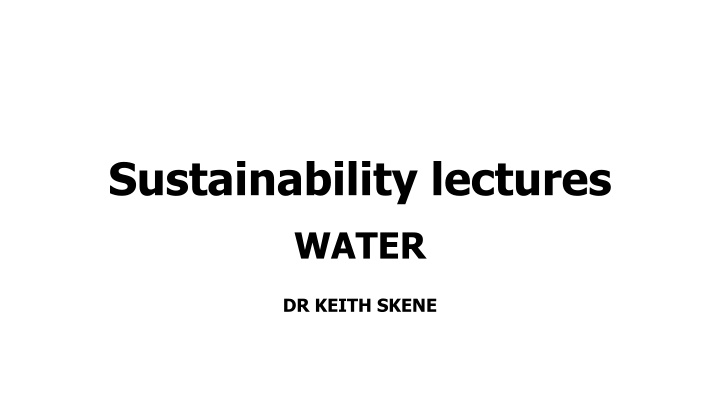
Perspectives on Water: Indigenous Wisdom and Modern Sustainability
Explore the profound connections Indigenous cultures have with water, viewing it as a gift and life force. Contrasting perspectives with modern sustainability reveal challenges in managing water as a resource for economic gain.
Download Presentation

Please find below an Image/Link to download the presentation.
The content on the website is provided AS IS for your information and personal use only. It may not be sold, licensed, or shared on other websites without obtaining consent from the author. If you encounter any issues during the download, it is possible that the publisher has removed the file from their server.
You are allowed to download the files provided on this website for personal or commercial use, subject to the condition that they are used lawfully. All files are the property of their respective owners.
The content on the website is provided AS IS for your information and personal use only. It may not be sold, licensed, or shared on other websites without obtaining consent from the author.
E N D
Presentation Transcript
Sustainability lectures WATER DR KEITH SKENE
Water: a simple molecule, a complex relationship with humans The M ori view water as a taonga, a gift, passed down from the higher powers, Consequently, M ori people treasure and respect it Lake Taupo, New Zealand
The Washoe tribe of Lake Tahoe Water is quite simply seen as life not only does it sustain life, but also it is a life force itself Far beyond an ecosystem service provider
Dreamtime stories The role of spirits in creating sources of water and the ongoing supply and control of these watercourses by ancestral spirits and creation beings
Marker trees and bird species have been used to find water sources Ecological mapping, combining storytelling, landscape and other species
Water is the life for us all. Its the main part. If we are gonna loose that I don t know where we gonna stand. If that water go away, everything will die. That s the power of water. He connect with the land. Pukarrikarra (the dreaming) put em all together. One life. John Dudu Nangkiriyn Karajarri people.
Indigenous and non-Indigenous perspectives of water and its management differ greatly Indigenous thinking views land and water as one An idea now emerging in modern sustainability policy This creates difficulties as non-Indigenous laws and management plans separate land from water and generally regard water as a resource available for economic gain.
Celts and water Water bodies were venerated Ritual sacrifices into lakes and rivers Such as at La T ne Gateway to the Other World T r fo Thuinn land under the sea
Celts and water Remember the Voyage of Bran? The Otherworld as below the ocean Possibly a reference to the ice age lands now covered The world of the ancestors
Danu Goddess of the Earth, rivers and wells Great mother of all other gods and goddesses The people of the Goddess Danu. The Riders of the Sidhe by John Duncan (1911)
Why is water such an important molecule? So simple yet so complex?
Biology is based on chemistry Chemistry is based on physics
Polar solvent Able to dissolve ionic molecules
Polar solvent Membranes are essential for life Membranes can remain intact (they are made of special lipids with polar heads) where reactions within the cell membranes can occur They allow compartmentalization and protection
High melting and boiling points High specific heat (energy needed to raise temperature of 1 kg by one degree C) Allows maintenance of temperatures Important for consistent enzyme rates Important in heat transfer around the body
Latent heat of vaporization Heat required to move from liquid to gas phase High because of need to break hydrogen bonds Allows evaporative cooling E.g. sweating do not wipe sweat away, let it evaporate!
Water as a reaction medium and a reactant Water as reaction medium due to polarity As a reactant, water can be formed or split Water splitting reaction is extremely important
Water as habitat High surface tension Reactant Dilutant Buoyancy High specific heat capacity (slow to change temperature)
Water at 4 degrees centigrade is denser than ice
The Blue Planet A symbiotic relationship exists between water, weather, climate and all life on Earth As recognized by all indigenous people.
Water vapour as the major greenhouse gas Through its properties as a greenhouse gas, water vapour determines the Earth's temperature, making the planet habitable It allows the oceans to exist in liquid form so that they can transport heat and nutrients around the Earth system
Tundra Boreal Deciduous forest Alpine Grassland Desert Tropical rainforest Savanna Mediterranean
The equator receives more energy per unit area than higher latitudes
As a result Warm moisture-laden air rises at the equator
The moisture condenses and provides the rain that nurtures tropical rain forests. Rainforest
The birth of circulation The cool air now above the equator is pushed towards the poles by rising air below. As it moves, it radiates more heat into space, and descends at around 30 degrees N and S. Rainforest
The equator gives birth to the deserts At the surface, this cold, dry air draws moisture From the land, creating desert regions Centred at 30o N and S Desert Rainforest Desert
And the deserts feed the rainforest The descending air now divides at the surface, part returning To the equator and part Heading towards the poles, Both laden with moisture. Desert Rainforest Desert
If we consider the desert and equator section, it can be seen that a circular pattern of airflow occurs. This is called the HADLEY CELL. This cell results in moisture being moved from desert areas to the equator in a giant conveyor. Desert Rainforest Desert
Six rotating belts of air cells surround the planet Polar cell Ferrel cell 60N 30N Hadley cell Dry air descending, low precipitation equator 30S Moist air rising, high precipitation 60S
The relationship between the cells and the biomes 90 N Tundra and Taiga Sparce precipitation all year Polar Cell Temperate forests/grasslands Ample precipitation All year 60 N Ferrel Cell Savanna and Scrubland Winter wet, summer dry Deserts Dry all year 30 N Tropical seasonal forest and savanna Summer wet/winter dry Hadley Cell Tropical rainforest Ample precipitation all year 0
The soil-forest-water-civilization nexus Forests are major contributors to rainfall, with the Amazon rainforest producing some 70% of precipitation in the Rio de Plata river basin This is through evapotranspiration and the production of microbes and organic compounds which act as condensation nuclei for cloud formation and rain events.
It is estimated that deforestation may account for as much as 18% of current global warming Deforestation also reduces soil structure and organic carbon content negatively impacting the water-holding capacity
The biotic pump Forest releases water which supplies the aerial or flying river Allowing rainfall further inland Self-sustaining until the forest is chopped down
Deforestation and water relations Deforestation has three significant impacts in terms of hydrology: - soil erosion - eutrophication - soil salinization.
1. Soil erosion Since water is no longer escaping into the atmosphere through plant leaves It now runs along the ground, moving the soil into nearby streams and lakes. This leads to eutrophication.
2. Eutrophication Soil carries large amounts of nutrients into the water This alters the aquatic ecosystem massively as nutrients are a key limiting factor to population of growth
3. Soil Salinization Currently, 25% of the world s cropland is affected In Africa, this figure is 50% By 2050 it is estimated that some 50% of cropland will have productivity halved due to build-up of salt in the surface soil Soil salinization is very difficult to reverse.
Two routes to salinized soil 1. Irrigation in semi-arid zones Each drop of water contains a tiny amount of salt Over time, this salt accumulates in the soil.



